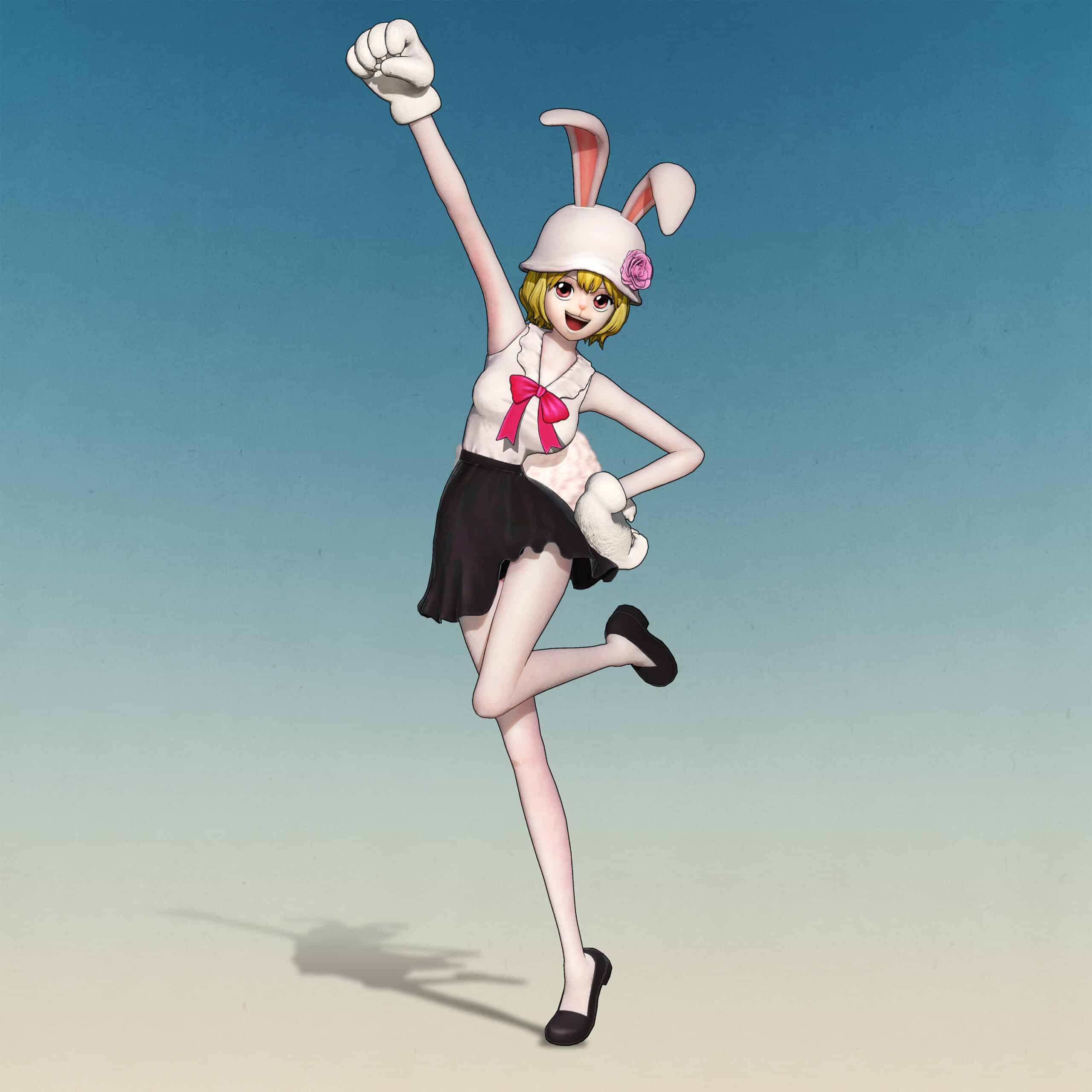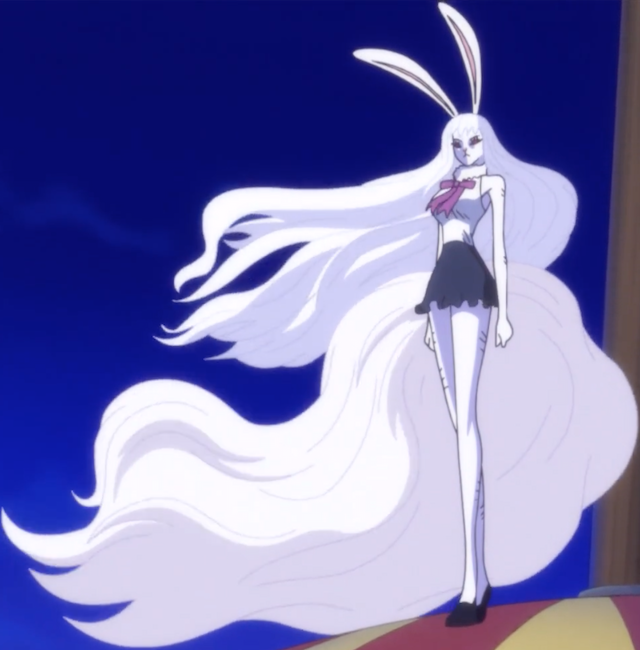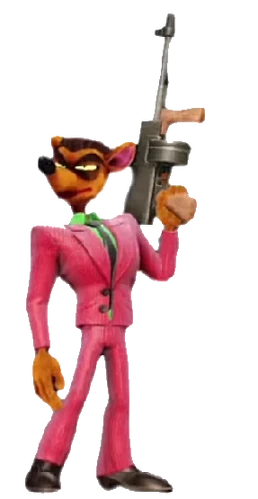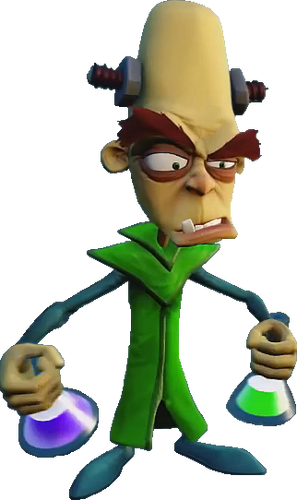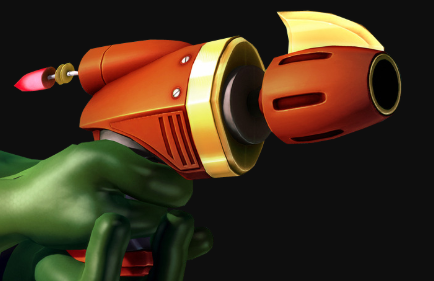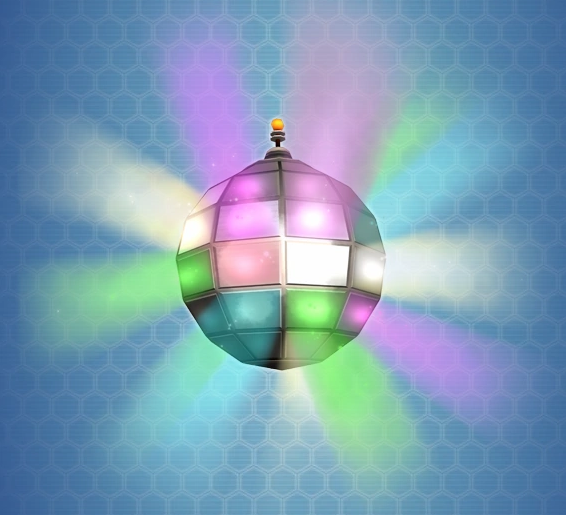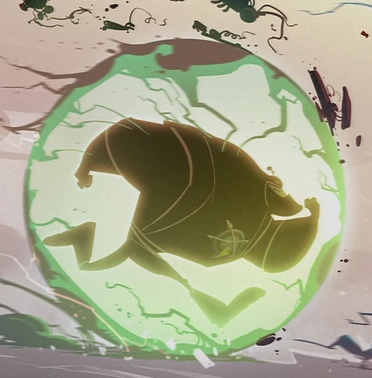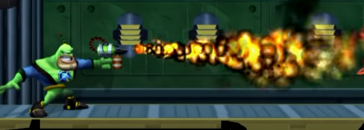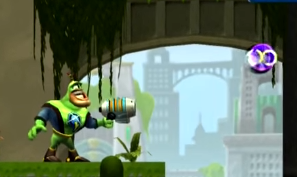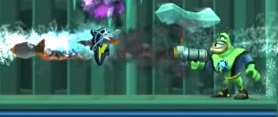Captain Qwark
Captain Copernicus L. Qwark is a major character in the Ratchet & Clank series, first appearing in the very first game, and making appearances in almost every game afterwards, barring some exceptions. Qwark is allegedly the greatest hero in the galaxy, having gained great fame and fortune selling stories of his heroic deeds, his most famous being when he saved Metropolis from a robotic invasion from the villainous Dr. Nefarious, his arch-nemesis. Qwark, however, is washed up, and not exactly an ideal hero when it comes to ideals.
In the first game, Qwark is actively a villain, teaming up with Chairman Drek so he can become the spokesman of Drek's new planet, thus making him millions. He was defeated by Ratchet & Clank, but returned in the second game as the primary antagonist, though you don't learn that until the end of the game. There, he manufactures the Protopet threat in the Bogon galaxy, hoping to form a market in the new galaxy. In the third game, Qwark is a more heroic figure, though still very antagonistic to our main characters, as he seizes control of the fight against Dr. Nefarious, but never does anything himself, and eventually locks himself away in a hideout out of fear. The end of the game, where he returns to fight of Nefarious, is basically the end to his arc.
From there on, Qwark's appearances are more minor, appearing during short sections of the games, usually during the intros and battle arenas, but he's now distinctly a protagonist, though still a coward. Qwark has even been playable in multiple games, sometimes with his own unique gameplay style, like in Up Your Arsenal and Secret Agent Clank, sometimes as part of co-op gimmicks, like All 4 One and Full Frontal Assault. He's played many roles over the years, a salesman, a villain, a nurse, but there's one thing Qwark will always be: A doofus.
Qwark is one of the most popular characters in the franchise, and being the greatest galactic hero of all time, it only makes sense for him to join Playstation All-stars Battle Royale.
Er, wait. Super Smash Bros. I meant Super Smash Bros.
Stats
Weight - 95
Walk Speed - 1
Run Speed - 1.5
Air Speed - 0.95
Fall Speed - 1.7
Qwark is built like a heavyweight, a heroic mass of muscle and machismo, larger than most characters and standing roughly as wide as Bowser and as tall as Ganondorf. You might think this means he's a super heavyweight, but shockingly, he's not! He falls directly into the middle of, uh, middleweight. This doesn't actually mean he's that light in-canon, it's actually a gameplay representation of Qwark really not liking getting hit. Other than that, his stats are mostly lined up with usual heavyweight stuff, meaning that, well... Qwark is at a distinct disadvantage compared to other middleweights, and especially compared to heavyweights.
His idle stance has Qwark copying his idle in the Qwark Vid-Comics from Up Your Arsenal, except transposed onto his newer design from Ratchet & Clank 2016. The rest of his animations are less cartoony than the Vid-Comics, matching up with his animations in the later multiplayer games he's featured in.
Specials
Neutral Special - My Blaster Runs Hot
The attack based on the minigame based on the fictional movie! Captain Qwark readies his signature red blaster (As seen in A Crack in Time), and fires a purple laser shot from it. The laser shot is similar in size to an uncharged Super Scope pellet, and flies at a fast speed with 3.5 Grid Blocks worth of range, but flies fast enough that its gone in only a few frames. The laser is incredibly weak, only dealing 0.5% and, well, basically no knockback of any kind. This makes it, well, pretty actively bad as a basic projectile, but you should probably guess that this isn't everything the move can do. If you hold the button down, Qwark will continue to fire the blaster, firing out four more of the purple laser shots.
Once those four shots have been fired, the gun will then fire out blue shots that are slightly larger, and after that, larger green shots, then even larger orange shots, and then finally ending with one very large red shot. This equals 17 projectiles shot throughout the attack. Once this red shot fires off, Qwark's blaster will overheat and he'll quickly fumble with it before putting it away. We're going to have to break this down shot-for-shot, so let's start with damage. The blue and green shots each add on an extra 0.5%, meaning that they deal 1% and 1.5% respectively, while orange adds on 1.5% for 3%, and the final red shot adds 7% for 10%. The purple and blue shots don't deal knockback, while the green one does flinching knockback. The orange one deals light knockback that can KO in the early 200%s, while the red shot can KO in the mid 100%s, making it decently powerful for a projectile.
The size of this is a bit harder to elaborate on in a text-based medium. The best way to describe it is that the first shot is an uncharged Super Scope pellet, but the final shot is a fully charged one, with the middle three falling between those two ends. I hope that makes sense. Anyway, the whole attack takes around 4.5 seconds to do in full, with the red hot shot having very bad ending lag as mentioned above. However, if you stop using the attack at a certain point, you will have a roughly 2 second buffer before the attack resets to the first shot, meaning that if you start firing before that, you will return to the charge that you were at when you canceled the move.
Once the red hot shot has fired and Qwark has put his blaster... somewhere... there will be a 5 second period where the move cannot be used as it needs to cool down. This is shown on Qwark's HUD as an icon with a gun and a cross over it, which vanishes when he's ready to use it again. Oh yeah, and Qwark can both move AND fire the gun in the 8 cardinal directions, making this even crazier! He can even jump and fire at the same time, but only if you have jump assigned to a button, since the precision aiming will cancel out jumping while you use it. Qwark's blaster is a major part of his gameplan, basically acting as a deterrent to keep opponents out of any kind of close range, where Qwark is the... not-strongest. Listen, it's not that he's bad at hand to hand combat, this is an ingenious strategy!
Side Special - Groovitron
Taking advantage of one of the most overused weapons in the series, Qwark quickly tosses a Groovitron out in an arc. The Groovitron is around the size of a Smart Bomb, but looks like a miniature disco ball. The arc that Qwark throws it at is low, travelling at half the height of a single Grid Block, and landing 2.5 Grid Blocks away from him. During this throw, the Groovitron is actually treated like a thrown item rather than a projectile. If it hits an opponent, it will deal 2% and very little knockback with decent hitstun, but it doesn't really need to do that. The throwing animation is slow, on the same scale as Snake's grenade toss.
If you've played the Ratchet & Clank games, you know where this is going. Once the Groovitron hits the ground, or an opponent or wall, it will float up from where it impacted, roughly 1.5 Grid Blocks high, and let out an AoE disco effect around it while letting out of a handful of songs that overrides the background track. You know, like flashing lights and stuff. This disco effect is roughly 3/4ths as large as a full sized Smart Bomb explosion, meaning it covers a fairly ridiculous amount of space. If an opponent enters this area, they will suddenly gain an uncontrollable urge... to start DANCING!
This works on every character, including Ganondorf and Ridley, and every character created for MYM. Every character has a unique dancing animation that they will perform while in the Groovitron's area of effect, Mario will perform his idle dance from Superstar Saga, Mega Man will do the robot, K. Rool will do a pirate jig, so on and so forth. Even Qwark will groove a bit if he's in the area, but he isn't affected by the Groovitron's negative effects. While an opponent is dancing, they won't be able to attack, and have considerably reduced jump height, cutting their basic jump down by half and removing their double jump, and their speed is reduced by half as well. Characters will still be dancing while performing all these actions, of course. They will also take the same knockback, but are reset to normal when hit, and if knocked out of the AoE they will be returned to normal. If the knockback is light enough, the opponent will only gain a brief grace period to try and escape, or else be thrown back into a dancing nightmare.
This only lasts as long as the opponent is in the area, though there are some limitations beyond that. The main one is that opponents need to be on the ground for the effect to activate, as it doesn't affect opponents mid jump (no easy ledge kills there, sorry). The Groovitron will also only last 15 seconds before it explodes in a puff of smoke. But opponents don't just have to avoid the area for those 15 seconds, as they can take matters into their own hands. The Groovitron can be destroyed by any attack, or by a dancing player running or jumping into it. This makes projectile characters particularly keen for clearing out a Groovitron, as they just have to line themselves up correctly and fire.
But, this does take pressure off Qwark for a moment. Just long enough for him to come up with an ingenious plan! The Groovitron is an obviously high utility move, as it allows enemies to become easy pickings to Qwark's ranged weaponry, particularly his blaster thanks to its low knockback for most of its hits. It's great at stage control as well, as Qwark can hide... uh, tactically retreat to its AoE to prevent opponents from coming near, while blasting at them. This strategy isn't always great, mostly against other ranged characters, but its fantastic for melee characters. I can't think of anything else specific, it's a large AoE that stuns opponents, its just useful in general.
Final notes: Qwark will enter an 8 second cooldown once one Groovitron explodes, with his antenna lighting up once its ready to use. If you try to use the attack while during this cooldown, Qwark will let out a quip relating to him being out of ammo, while not actually performing the attack. If a thrown Groovitron is reflected, it will not become the opponent's, and behave like normal, activating once it hits.
Up Special - Galactic Ranger Jetpack
Captain Qwark must soar like an eagle! Qwark's jetpack appears on his back, and he quickly rockets directly upwards, with him letting out a scre... heroic battle cry as it happens. This turns Qwark's entire body, every rippling muscle of it, into a hitbox, dealing 10% and upwards knockback that KOs fairly late. This isn't much of an attack, but Qwark will travel 5 Grid Blocks, making it a fairly great recovery if you're just going by distance. It also has mediocre start-up, comparable to slower end recoveries but not as bad. Of course, this isn't all, as once Qwark reaches the apex of his flight, he'll enter a Peach-esque gliding phase... except this is quite a bit different.
Like Peach's float, Qwark can move from side to side at his max air speed from where he stopped, and double tapping down will cause him to exit the float. However, unlike Peach, Qwark can hold this glide for much longer. Specifically, he can glide for 10 seconds, which is quite a long time. Of course, if Qwark is hit during this, he will be knocked out of the glide, causing him to enter special fall. While this is obviously great for camping and recovery purposes, there's an extra bit here, as Qwark can use a number of attacks from this vantage point! Specifically, he can use his specials, aerials, and even his smashes! With all this at his disposal, Qwark has a lot to work with for a full frontal aerial assault!
However, you need to keep in mind the time limit, and even more than that, the resulting cooling period. Once Qwark hits the ground from his special fall, he will have to wait 5 seconds before he can use specifically the hover again. He can use the rocket jump at any point, but it isn't as good of a recovery without it. Being in the air isn't all it's cracked up to be of course, as the time limit and limited movement options make so its very easy for an opponent to knock you out of it, so it's best to play it safe, even when firing your guns.
Also, did you know that Qwark never had a jetpack before the movie/2016 remake? I know, I think I tricked my brain into thinking he had one before hand, but he never did! It's a very seamless addition to his design.
Down Special - Quantum Deflector
Qwark quickly throws up a floating green device in front of him, which quickly lights up and emits a green force field around him. The force field is around the size of Qwark's normal shield, though perhaps larger by a small, barely noticeable amount. There are a few differences, as the Quantum Deflector won't shrink while it's out, and opponents are capable of entering the space it covers. While the shield is around him, Qwark can move around like normal, but now has a few limits placed on his moveset. He now can't use any weapon based attack, only his melee based ones... and his jetpack. Basically, he can only use USpec, Standards, DAir, NAir, and Grab/Pummel and his throws.
This massive limiter placed on Qwark is evened out by the actual function of the Quantum Deflector: It completely nullifies ANY attack that hits it! Even if the opponent attacks Qwark from inside the bubble shield, the damage will be redirected to the shield instead. And get this, it blocks out 40% damage (This is multiplied in 1v1 matches, much like how regular damage is) before it vanishes! Well, it also vanishes after 20 seconds of use, too, but the damage is more impressive. It will also passively damage anything inside the shield area for 1% every 30 frames. This makes the Quantum Deflector the perfect tool for
running away in terror retreating and coming up with a new strategy, as opponents have no real reason to go near Qwark until his shield gives way. The Quantum Deflector will actually start absorbing damage as soon as it first appears (the device that Qwark uses), meaning that Qwark only has a very brief moment of vulnerability when using it. However, when it runs out, it breaks immediately, the device exploding and Qwark becoming instantly vulnerable.
However, there is another downside. The Quantum Deflector is a powerful tool, and as such, Qwark only gets 2 uses of it per stock, like Banjo's Wonder Wing. And beyond even that, each use has a 10 second cooldown period. With limited uses, Qwark will need to strategeristically figure out when to use it. The obvious application is using it when things have gone bad, but when does anything go badly for Qwark? Never, that's when. Obviously you'll want to use this to give Qwark an added edge in close quarters, as its added damage and protective aspects allow his mighty blows to hit harder and easier! Just remember to keep in mind the limits the move puts on you.
Smashes
Up Smash - Warmonger
Qwark readies his Warmonger, aiming it upwards before firing a single missile from it. The start-up of the attack is slow, as Qwark hefts the weapon over his shoulder and takes a knee. Him aiming the Warmonger is also the charging animation, and upon release, the missile launcher will... launch a missile. The missile is equivalent in size to Samus' Power Missiles, and will travel 3.5 Grid Blocks directly above Qwark before it explodes. On hit it will deal 13-23%, with heavy knockback that can KO in the mid 100%s, making it a decent kill move. The issue is that the missile itself is fairly hard to hit with, thanks to its small hitbox and there not actually being a melee hitbox to launch the opponent upwards. This means Qwark has to rely on actually hitting the opponent while in mid-air in order to fully use this to his advantage. However, he CAN aim it left and right at 45 degree angles while charging, making it not as bad. It also has pretty bad ending lag, but this is made up for by the next paragraph.
But it isn't all safe on the ground when the Warmonger is around. Once the missile explodes, whether it hits anything or not, 4 pieces of flaming shrapnel will launch from it in different arcs, two closer to where the missile was, two farther away. The inner shrapnel will fall 0.5 Grid Blocks away from where Qwark fired the Warmonger, while the outer shrapnel will end up landing 1 Grid Block away from the inner two. Once the shrapnel pieces hit the ground, they will also explode. The hitboxes on the pieces of shrapnel are roughly Capsule sized, with it expanding out slightly once they explode. The shrapnel pieces aren't strong, only dealing 3% with little knockback but high hitstun, but who are we kidding, raining down death on your enemy is just fun to do.
The Warmonger can be used while Qwark is hovering with his jetpack, and there isn't much to it. There's an animation difference where Qwark won't kneel, but it isn't particularly useful, considering the attack is an anti-air itself. It can make it easier to KO opponents, and you CAN combo from the jetpack to the Warmonger at lower percents, though it has very tight timing. The Warmonger, as mentioned before, is an anti-air, but also one of Qwark's best KO moves. Sure, it requires getting the opponent into the air, but Qwark is great at controlling the distance between him and his opponents. Throw a Groovitron out and watch your opponents jump right into your line of fire! Hopefully, at least. The shrapnel, however, instead works AS a form of stage control, giving Qwark slight defense if he whiffs the Warmonger. He can also use the shrapnel as cover for when he exits the jetpack hover, as it falls slightly faster than his own max fall speed.
Down Smash - Fusion Grenade
Qwark holds up a glowing object in his hand for the charging animation, before throwing it down at the ground upon release. Not a cheap smoke bomb this time, Qwark has instead thrown a Fusion Grenade, which explodes into blue energy around him. The start-up of the attack is light, but it has some noticeable endlag, enough that whiffing it can be trouble at high percents. The explosion's radius is also fairly small, hitting 0.4 Grid Blocks away from Qwark on either side. On hit, the explosion will deal 11-20%, with backwards knockback that KOs at around 170%. This makes it less useful as a kill move for Qwark, but it is a bit easier to hit than the Warmonger is. If you're wondering why Captain Qwark isn't hurt by the explosion, it's a well known fact that Qwark's chiseled abs are immune to explosions.
The attack might seem fairly basic on the surface, but it gets much more interesting if you use it while in jetpack mode. While in flight, instead of the bomb simply exploding at Qwark's feet, it will be thrown directly downwards as a projectile. The grenade is roughly the size of a Mega Man pellet, and falls at a fairly decent pace. Upon touching anything, it will explode, dealing the same damage, but revealing the full scope of the hitbox, being a smaller explosion in a circle, similar to Samus' bombs. The knockback of the attack is also changed to radial. This is sort of a reverse version of the Warmonger, as it is much easier to hit with, and... goes downward.
The grounded version can act as a secondary killing Smash, or other basic DSmash needs, like catching recovering opponents, but its weaker range makes it a bit of a mixed bag. The aerial version, however, lets you rain even more death on foes, with easier aiming thanks to the jetpack. This can be especially devastating off-stage, but you always need to keep in mind Qwark's jetpack fuel. Get a bit overzealous and you'll end up falling off, yourself!
Forward Smash - Agents of Doom
Qwark prepares possibly the most 2000's weapon name in the series, holding another glowing object in his hand. This is, again, the charging animation, but on release Qwark will instead throw a red projectile down 0.5 Grid Blocks in front of him. The projectile will explode into 1 to 3 small mechanical fellas, the titular Agents of Doom. This opening is relatively quick, but doesn't have a proper hitbox attached to it, as the Agents themselves will act as the hitbox. It also has low ending lag, making it fairly easy to throw out.
For the Agents themselves, they use their 2016 design, and are roughly 3x3 of the smaller grid blocks in size, making them particularly small, standing roughly to Qwark's knees thanks to how small his legs are. The Agents are fully autonomous minions, and will run towards the nearest opponent (or anything with a hurtbox) as soon as they come within 4 Grid Blocks of range. If there isn't an opponent in range, they will stand still until there is, and will return to standing as long as there isn't anyone within their range. Once the Agents get within 1 Grid Block worth of range from the opponent, they will launch themselves at them using a rocket thruster, exploding on contact and dealing 10% with average knockback. The Agents can activate their thrusters from whatever direction they require, and once they lock on the only thing the opponent can do is shield or dodge. The Agents will fly until they either hit something or go off screen in the case of a dodge. Jumping won't help opponents, as the Agents have a slight homing ability that will basically allow them to hit as long as the opponent's hurbox is still visible.
As you might be able to sus out by now, the charging for this move doesn't affect the damage the agents cause, but rather how many of them there are, 1 for no charge, 3 for full charge. This ultimately does result in just a damage boost, a pretty massive one at that however, as Agents tend to stay clustered together - though them breaking off and attacking multiple opponents isn't unheard of. Qwark can throw down some Agents of Doom while in the jetpack, and while this doesn't have any unique properties, it allows for much sillier throwing angles. Qwark will throw the initial glowing orb down at a diagonal direction, where it will fly until it either hits something or goes off stage. On hit, it will create however many Agents the charge denotes, and you may in fact just be able to hit an opponent with all of them instantly if you manage to hit someone. The main use of the aerial version, however, is to place Agents over at a different side of the map than Qwark. Think of it as a scouting mission while Qwark prepares for the main event, and definitely not him using someone else to do his dirty work.
The Agents of Doom are great protection, as they can easily distract an opponent for a short time, taking the heat off Qwark while he does something else, like set up a Groovitron or prepare his blaster, or prepare cup of coffee, I dunno. Despite their average knockback, they can deal big damage when fully charged, though they are relatively easy to avoid if the opponent is paying attantion. The big downside is that you can only have 1 set of Agents on stage at a time. If you use the move again while any Agents are out, they will burst into non-damaging explosions, making way for the new Agents. Agents also have an unlimited time on the stage, but their AI means they won't be around for long. Make sure to use your current agents to the best of their ability before summoning in new ones.
Standards
Jab - Crouching Kitten Style
Qwark unleashes his mighty fists of justice on the enemy! Channeling days of martial arts training, Qwark does a left hook, a right hook, and then a spinning back hand for a basic three hit combo. This may sound like an average jab combo, but much like Qwark himself, it's far from it. The first two hits are lightning fast, comparable to pretty much every jab combo in the game, but the final hit takes a while to actually land, making it one of the slower jab hits in the game. As you might expect from this, the trade off is damage. The first two hits only deal 3%, with very little knockback, and the last hit dealing 7%... with slightly better knockback.
The attack really won't KO until really late, unfortunately, but obviously Qwark doesn't want to have to get his hands dirty unless he absolutely has to. But when that time comes, Qwark will rush valiantly into battle, as each hit of the attack pushes Qwark forward a small, but noticeable, distance. This allows Qwark to, among other things, use this as a decent spacer at lower percents, giving Qwark room to hit with one of his guns, or make a strategic retreat. The issue is that the final hit has pretty bad ending lag as well, meaning that if you whiff... well, you know what would happen. It can also be used to KO at very high percents, or even push yourself out of a disadvantageous position, or even push opponents into your various lingering projectiles. With the Quantum Deflector up, thanks to its defenses, this can even become a good pressuring tool.
Forward Tilt - Mighty Kick
Qwark pulls up his leg, and then uses his incredible strength to powerfully push it forward. The kick has fairly short range thanks to Qwark's, uh... "compact" legs, with it having significantly shorter range than his Jab. The attack has fairly high starting and ending lag, making it Qwark's slowest standard, though it has super armor on the start-up to make sure opponents can't knock him out of it with a weak attack. This is at least made up for with it being the strongest of his standards as well, though the actual properties of the hit are a bit strange.
On hit, the kick will deal 12% and cause opponents to take VERY shallow backwards knockback, shallow enough that it looks like they're sliding across the ground rather than actually being knocked away. It still knocks opponents decently far away, though it can only kill in the mid 200%s. Even with that low-ish knockback, the kick has a few... Qwark-ian uses. The main one is getting opponents away from him, not because Qwark doesn't like being up close to his opponents, its just part of his heroic plan he's definitely not improvising. This is your main keep-away move while on the ground, even with its bad start-up. It has high hit stun as well, so an ideal way to keep opponents away, if you have it set up, is to hit them with the kick while they're stunned by a Groovitron. The kick can also knock opponents directly off stages, giving Qwark a good chance to hit an opponent with a weapon off-stage. A more advanced technique is that you can actually use this to punish a ledge roll, but thanks to the starting lag, this is very difficult to pull off.
Down Tilt - The Q-merang
Get it? It's a boomerang, but a Q, for Qwark. It took him months to come up with it, and trademark it of course. Qwark's crouching position is... pretty bad, as you might expect from a guy who is 80% upper torso. It's similar to Bowser's in terms of how good it is at actually avoiding things, AKA not good. Notably, Qwark will keep one hand over his head, with a very noticeably worried look on his face while he's crouching. He's not scared, though, he's just... concerned.
Anyway, for the actual attack, Qwark will take the hand he's using to cover his head, and quickly throw a spinning, double bladed boomerang-esque projectile forward. The Q-merang is roughly Metal Blade sized, if slightly smaller, and will travel forward 2.5 Grid Blocks, before pausing for a few frames (with hitbox still active), and then returning back to Qwark. Qwark can move around almost immediately after the Q-merang is thrown, and it will always fling back to wherever he is. The return trip isn't a hitbox, fortunately for the opponent. The Q-merang is noticeably weak, dealing 6% with very, VERY weak knockback. This does, however, play into its main use.
While FTilt is based around getting enemies off you that are already very close, the Q-merang is based on halting approaching enemies. It's fast, and while the actual attack might be weak, it deals decent hit stun. If you can manage to hit an opponent with it while they're on the approach, then Qwark can very easily make a tactical retreat and start blasting at the enemy, or you can stun them for a moment and leave them to the mercy of your Agents of Doom. Its speed can be used to knock opponents out of their own attacks thanks to it having high-ish priority as well. This is also notable for being the only projectile-like attack Qwark can use while the Quantum Deflector is up, giving him a bit of added defense. It is absolutely not an offensive attack, however, though using it to get a quick 6% won't like, harm you that much.
Being a boomerang, the Q-merang will return to Qwark after a few frames of hovering in place. The hitbox remains active, allowing Qwark to hit opponents that could've leaped over or dodged through the attack. However, the return trip is even weaker, dealing basically flinching knockback and only 4%. This isn't great, but it can still be used for a brief diversion, letting Qwark get away or give him just enough time to finish off whatever he was planning in the first place.
Up Tilt - Gun Trick
Qwark quickly pulls out his blaster, but instead of firing it, spins it around quickly performing an "impressive" gun trick, winking to the camera as he does so. This attack is a single hitbox despite what the animation may look like, with it activating as Qwark starts to pull out his gun, and continuing as he spins it around. This is a fairly standard UTilt in terms of utility, acting mainly as a a quick anti-air, as it hits slightly diagonally above Qwark's head, and knocks opponents upwards for 8%. The hitbox itself lasts for a bit, but its angle means that it is difficult to hit shorter or crouching opponents.
This can actually combo into some of Qwark's gun attacks, most notably his NSpec, which can true combo from UTilt at lower percents. At higher percents, UTilt will instead knock opponents directly out of the range for any of NSpec's angles, but it can instead go into UAir. You can even use this to your advantage and fire a few of the weaker NSpec blasts at them in order to rev it up! The attack has a bit of ending lag as Qwark will once again put the gun... somewhere, taking a fairly decent amount of time to do, roughly the same as NSpec's endlag, as it basically uses the same animation.
Dash Attack - Heroic(?) Charge
Qwark dashes forward, shoulder first, making a brave dash towards the enemy. This is a somewhat basic charging attack, boosting Qwark's speed and momentum while it's active, similar to a Dash Attack like Ganondorf's. This has a much larger hitbox thanks to Qwark's hulking mass, which also means this gets more range than Ganon's dash as well. Basically, the hitbox takes up the entire front of Qwark as he dashes, not much else beyond that. It has decent start-up, but lasts for a bit, though the actual ending lag isn't bad.
The main interesting note is, that like most of Qwark's melee, the attack is a LOT weaker than it looks. It only deals 9%, considerably low for a Dash Attack, and has very low knockback - but this isn't without a purpose. For one, this is a good way to get opponents off of you, as while the knockback is weak, it's only unsafe at lower percents. As said, the knockback is low, so it won't be useful for killing, but it does have a decent use: Getting opponents into your Groovitron range. The knockback not only is low, but has low ending lag as well, meaning that opponents close to the Groovitron, whether they avoided it or just escaped, can be easily pushed in again. This becomes a bit of an obvious tactic if done too much, however, as the projectile based Qwark should only enter when forced to, so it can become a bit suspicious when you see him rushing into combat.
You can also follow it up with FTilt, which can allow him to knock opponents into some of his existing set-ups. This is a bit of a risky technique by itself, as neither attack is particularly powerful. You may even be able to condition the opponent into using a defensive technique when they see you rushing in, allowing you to instead follow up with something more devious. I mean, heroic. This can still become too much of an obvious move if you use it too much, however.
Aerials
Neutral Aerial - The Perfect Specimen
Qwark quickly turns towards the camera and flexes his muscles so hard that a glistening aura appears around him, damaging anyone that gets within range of him. Aside from the comical animation, this is a fairly basic NAir, with rather quick start up, though high ending lag. The range can be compared to other NAir's, most obviously to larger characters like Bowser. The attack will deal 10% with average radial knockback, average being generally much less than a standard heavyweight.
This has fairly standard applications for a NAir, it's quick so it can be used out of a short hop, and it has decent range which lets it work as a decent keepaway attack, though it isn't great as a kill move. It can also be used while the Quantum Deflector is up, but pretty much shares the same role, even if it is redundant thanks to the Deflector's ability. This attack can also be used while in jetpack mode, which actually gives it more variety of uses. For example, you can hover off the stage and use it to bounce a recovering opponent back. If you're going in for an approach, you might even be able to psych the opponent out, making them go for a defensive action against a projectile when you're REALLY going for a close range attack!
Now let's talk about how the attack actually has multiple different animations, each one a different sort of flex, with the animation set changing depending on if Qwark is facing left or right. All the animations have the same hitbox, so you don't need to worry about that. Also, if you enter landing lag while using this move (which is likely, considering that it's fairly laggy at the end), Qwark WON'T perform some form of comical pratfall like most characters - instead, he'll land perfectly and continue flexing for a few extra frames, acting as the ending lag.
Forward Aerial - Flamethrower
Qwark pulls out the generic flamethrower weapon from his Vid-Comic adventures, and aims it at a downwards-diagonal angle, quickly shooting out a stream of flame from it. The fire reaches out 1 Grid Block of space, and is 0.2 Grid Blocks tall. These measurements are for the flame if it was going straight out, but it covers the same distance, basically. I don't need to write a chart for this, you can figure it out yourself. Anyway, the flamethrower fires out quickly, and has minimal ending lag as well - though it only comes out for a brief moment if you just press the button. HOLDING the button will have Qwark shoot the flamethrower until he either hits the ground or you release it.
It basically forms a wall of pain beneath Qwark, turning this into a really impressive approach option... though whether or not you want to approach the enemy does depend on how well Qwark is doing in the fight. If you don't want to approach foes, it can also act as a decent warding attack as well. The flamethrower will deal 5 hits of 2%, with very little launching power on the final hit. And yes, it will always only do 5 hits to an opponent at once, even if you hold it. You can cancel out of the hits by releasing it, which will put the opponent into light hitstun with flinching knockback, meaning that this is functionally Qwark's only combo attack - though, again, this is something you may not want to do.
For other uses, the flamethrower can be used in conjunction with NAir, as the flamethrower can interrupt opponents, while the NAir can deal a staggering blow. It can also be used as a light stalling tactic for when you're waiting for Qwark's various gimmicks to recharge. The big one is that this works incredibly well with NSpec, as you can go from firing shots to using the flamethrower very quickly, giving it extra defense while you charge it up. It's best to use this in small doses, mostly when you want an opponent to go away, as the added input means the opponent has a better chance of interrupting you or even dodging the final shot.
Up Aerial - Gravity Bomb
Qwark pulls out the Gravity Bomb gun, also from his Vid-Comic adventures, and aims it upwards, firing out a large purple orb with an infinity symbol on its side. Or maybe it's an eight. Anyway, this doesn't have an actual hitbox directly attached to it, with the bomb that's fired being the actual hitbox the entire time. It is also relatively quick, but not as fast as FAir or NAir, meaning it can't be used out of short hop. This is primarily an anti-air, so you think this would be a bad thing, but thanks to the properties of the bomb, it actually isn't!
The bomb is the size of a mid-charge Samus Charge Shot, and will be fired 1.5 Grid Blocks upwards, before hanging in the air and quickly falling to the ground if left alone. When the bomb hits the ground, it will bounce according to the game's physics, and automatically vanish after it hits the ground a third time, with each bounce getting progressively smaller because physics. There can only be one of the bombs on stage at a time, and it will be instantly replaced if Qwark attempts to shoot a second bomb. The bomb itself will automatically draw itself towards any opponent that comes within 3 Grid Blocks of it, at a sluggish pace, unfortunately, with its trajectory changing how it bounces if it misses.
If the bomb successfully drags itself over to an opponent, they will take 12% and average knockback that will KO in the late 100%s. This doesn't make it that great of a kill move, but it is passable. Its main use, as mentioned previously, is to be an anti-air, but with that... unique, Qwark style. Qwark can easily fire the bomb, and then leave it to home in on enemies. It doesn't have that great of a hit ratio thanks to its sluggish movement, but it can easily disrupt an opponent's plan in the air, the ground or even off the stage! But if you want it to hit a bit more often, then you'll most likely need to use Qwark's throws in order to shove them into a more easily hittable position.
Back Aerial - Missile Launcher
sorry, this is the best image you're getting
Equipping himself with the last of his Vid-Comic weapons, Qwark pulls out a missile launcher and quickly spins around, firing it out backwards. The missile is cartoony, and about the size of Samus' standard missiles. The missile travels slowly, much slower than most projectiles in the game (and that includes the Gravity Bomb mentioned above), but it also has infinite range, meaning that it will stay on stage for a LONG time.
This makes it an incredibly powerful stage control attack, as it basically prevents opponents from standing in one place for too long, or even just jumping around if placed correctly. Don't get too overzealous, because only one missile can be on stage at a time, much like the Gravity Bomb. On hit, the missile will deal 15% damage with decent knockback that KOs in the early/mid-100%s. This is extra good incentive for opponents to stay away from the missile, if they run into something so slow it's THEIR fault! Of course, there's still ways the opponent can turn this on you, so don't try to spam it TOO much. But.. maybe have one out during defensive plays, just to be safe.
Down Aerial - Intergalactic Slam
Qwark raises both of his fists, and then starts to fall downwards, slamming them against the ground as he hits it. This is basically your standard stall-then-fall type move, basically akin to Ridley's, though you can cancel out of this one at a much earlier time, as you might expect from Qwark. The ability to cancel out of the move earlier also means that the attack has less damage output, because balancing. It ultimately deals 11%, with a weaker than average downwards spike, though only if it hits opponents while in the air. This will also cancel out of it, allowing Qwark to perform a tactical retreat.
There's a secondary hitbox if Qwark lands on the ground and manages to hit someone, hitting on either side of him, with slightly distended hitboxes the width of Kirby. This is actually slightly more powerful, dealing 14% and upwards knockback that can KO in the early-mid 100%s, making it one of Qwark's strongest melee attacks. Of course, with how stall-then-falls work, you won't exactly be hitting with this too often... but you can use it to edge opponents away from you with the threat of actually dealing damage! Also, as this can be used with the Quantum Deflector on, it can be used to knock opponents away from the shield's range. Using it while Qwark's jetpack is active will automatically cancel the jetpack and make it to the ground much faster. You can use this to combo from any projectiles or attacks that don't require Qwark to be on the same level, like the Fusion Bomb or Agents of Doom. The increased falling speed also allows the Warmonger's shrapnel to cover you slightly better.
Grab Game
Grab & Pummel
Qwark reaches forward with his weird three fingered hand, in a fairly standard grab. This is comparable to something like DK's grab when it comes to range and lag, as both DK and Qwark have massive, chiseled biceps. Though obviously Qwark is much more handsome. When the opponent is grabbed, Qwark will hold them at arm's length, by the scruff of their shirt... or whatever is currently available if they aren't wearing a shirt. But nothing TOO inappropriate. Qwark doesn't usually want opponents up close, so his grab being this decent is at least something if you have no choice but to go old fashioned.
For his pummel, Qwark will perform two quick slaps to the opponent's face, ironically putting this on the slower end of the pummel speed spectrum thanks to it being a two hit. Each hit deals 2%, and while it is slower, it can still be used multiple times on opponents who have taken enough damage. It isn't anything spectacular, but it can be used to get some easy damage if you end up with an opponent in your grasp. Qwark's throws are mainly here to
get the opponent away from him show off his herculean strength, so higher damage is always a plus.
Back Throw - To My Biggest Fan
Qwark quickly flicks the opponent behind him, freeing them from his grasp and leaving them in a stunned state for a moment as the animation continues. Qwark will then pull out a pen and a photograph of himself, and start to sign it, muttering "To my biggest fan, yadda yadda..." as he does so. He then quickly slaps the photograph onto the opponent's face (without ever looking at them), causing them to recoil. Qwark will then dust off his hands and return to his idle stance.
This is the second weakest of Qwark's throws, as it will barely knock the opponent away, won't KO until around 300%, and only deals 8%. The upside, however, is that it has very high hitstun on the opponent, making it incredibly safe to use. With low knockback and damage, there's a very obvious way to use this. That's right, this attack's main purpose is to push foes into the Groovitron's range, giving Qwark enough time as he needs to do... well, anything he wants, as the opponent will be left helpless for quite a bit. This is also another great stalling move, as its lengthy animation can help keep the foe in their place while Qwark recharges. If the attack is used against a wall, it will force the opponent to recover low, something predictable enough that even Qwark can see it coming!
Forward Throw - Showing Off
Qwark quickly lets go of the opponent, flexing for a moment before he performs several quick karate chops on them. The karate chops each deal 1% to the opponent, totaling to 4%. He then realizes the chops aren't working well, and performs a straight punch on them, causing another 5% and launching the opponent at a nearly horizontal angle. As the opponent is launched, Qwark slicks back his antenna and shines a smile towards the camera. This is probably Qwark's best throw from a KO perspective, as it can KO in the mid-to-late 100%s on a few characters, but like most of Qwark's melee, it isn't very good.
The attack's comparative strength means that it's one of the best ways to get opponents off of Qwark, but it has the downside of, well, being a throw. This means the opponent already has to be in your face before you can use it, but it's good when that happens. As another benefit, it can knock opponents into the Groovitron easily thanks to its very shallow knockback, or set opponents up for Qwark's blaster. You can also follow this up with BAir, instantly setting pressure on the knocked back foe while you attempt to set up something
Down Throw - Champion of the Galaxy
Qwark quickly clonks the opponent over the head with the butt of his blaster, knocking them into an automatic prone position (and dealing 2%). Qwark then takes this opportunity to pose for the camera, stepping on the opponent's prone body and striking a heroic pose, as he has vanquished the vile foe. He then walks off the opponent's body, ending up on the opposite side of where he started. This is a rather long throw animation, with Qwark's steps acting as what causes the damage, totaling to 7%, making it still rather weak.
The attack has no launching power to it, but instead locks the opponent to a prone position that lasts based on their current damage. It lasts just long enough for the attack to be safe at lower percents, and long enough for Qwark to act out a plan (or just run away) before they recover at higher percents. At higher percents, this can be used to stall the opponents while something like the Agents of Doom or the Gravity Bomb home in on them. While this isn't as good a "get off me" tool as FThrow, it is good for set-up, mostly acting as another way to keep opponents off you while you set up a Groovitron, charge your blaster, or even just prepare a normal attack.
Up Throw - The Showstopper
Qwark quickly tosses the opponent upwards a short, fixed distance. As they fall back down, Qwark quickly preps for an uppercut, giving a quick smile and wink to the camera as he does so. He unleashes the uppercut directly to the opponent's jaw as they come back down, launching them. Qwark will flex his bicep for the end lag of the attack, which is fairly short. The main gimmick of this attack is that the knockback changes based on the input on the control stick, specifically up and down. Without holding the stick in either direction, the uppercut will launch the opponent a fairly mediocre distance, KOing at around 175% or higher.
Holding down, however, will reduce the knockback considerably, though this doesn't turn it into Qwark's worst throw, as DThrow is by default worse. However, this can't kill until incredibly late, to the point that you'll only ever see this in sudden death. It does, however, have slightly longer hitstun. By holding up, the knockback will instead slightly increase from the base, not by a lot, but enough to push it into the same KO range as FThrow. It can even KO earlier if you're high enough on the stage. This has less hitstun, though. Both versions deal 10%, making it Qwark's strongest throw damage-wise.
Both these variants have distinct advantages, for example, the weaker version can be used to help hit with some of Qwark's more specialized weapons, most notably the Warmonger, as the attack ends in the perfect angle and timing to follow up with it - though the opponent comes out of hitstun a few frames after the rocket fires, meaning that this isn't a true combo. Or you can start out a combo with Qwark's NAir. The stronger version can be used to make some space between Qwark and the opponent, he even has enough time to set up a Groovitron, or you can start firing your blaster at them. There's a lot of options!
Final Smash
Believe It, Toaster Head!
With the Smash Ball in hand, Qwark uses its power to... run away! How unexpected. He enters a brief cinematic where he performs a pose and teleports away in a flash of green light. That coward, running away in the middle of a fight... or is he? Surprisingly, he isn't as his ship from Ratchet & Clank: Up Your Arsenal will quickly fly from the side of the screen, launching a volley of missiles onto the stage, marked by a dozen Q-shaped markers appearing around the stage. The missiles will aim at these locations and explode when they reach them. the missiles aren't projectiles, and will phase through anything to reach where the markers randomly appear. The explosions are the actual hitboxes, dealing 20% on contact with heavy knockback, though noticeably weaker than most Final Smashes, and range equivalent to a Bob-Omb explosion.
There are two caveats for where a missile will fire at: The first is that two markers can't be at the same location, and the marker needs to appear somewhere a player can stand on. This means that this is a beast on smaller stages like Battlefield, where the opponents are sitting ducks, but this can be completely useless on larger stages like New Pork City, as there's simply too much space for it to reliable hit opponents. Of course, this single bombing run isn't all Qwark gets - no, he makes two more runs after it, meaning that a total of 36 missiles are fired, which means that _someone_ will end up being KOed. Once the third run is finished, Qwark will teleport back to the stage, and perform a pose, while saying a quip like "Hope you got my good side! Who am I kidding, they're all my good side!".


